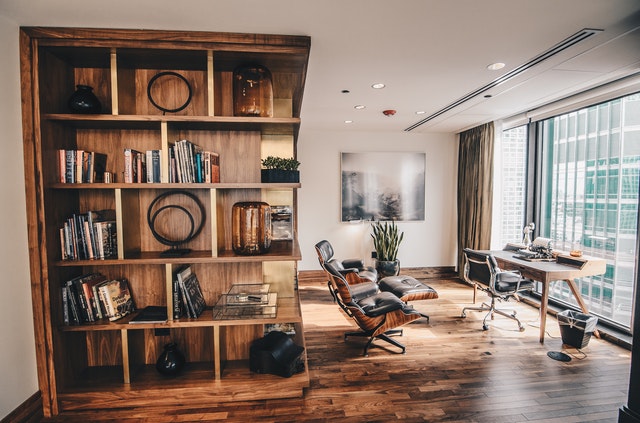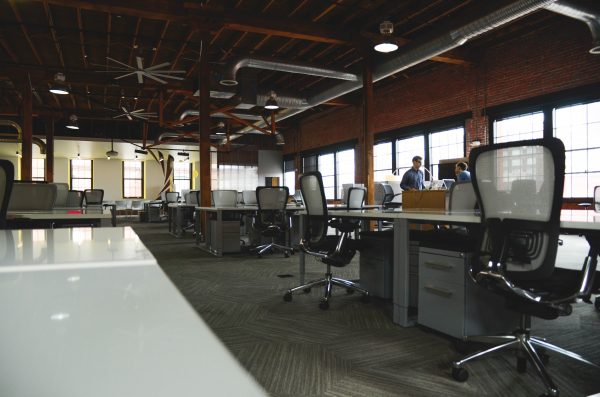Archive for the ‘Office Talk’ Category
August 26th, 2022
 Recent years have seen some major U.S. educational institutions enter into partnerships with providers of flexible office space, creating coworking solutions that have already proven to be highly beneficial to both parties. These coworking spaces have served to support students by providing a professional environment where they are encouraged to interact with other college students and engage in networking opportunities. The coworking communities that have been formed on college campuses across the U.S. have also helped to support businesses surrounding these emergent hubs, providing them with direct links to students looking to enter the professional world.
Recent years have seen some major U.S. educational institutions enter into partnerships with providers of flexible office space, creating coworking solutions that have already proven to be highly beneficial to both parties. These coworking spaces have served to support students by providing a professional environment where they are encouraged to interact with other college students and engage in networking opportunities. The coworking communities that have been formed on college campuses across the U.S. have also helped to support businesses surrounding these emergent hubs, providing them with direct links to students looking to enter the professional world.
Prior to 2020, the highly innovative coworking sector served to revitalize the somewhat stagnant office space market; experiencing healthy annual growth and gradually becoming accepted as a legitimate alternative to traditional offices. The shakeup caused by the COVID-19 pandemic, however, decimated the coworking space market, limiting growth and forcing coworking space providers to consider short-term alternatives.
Many of the partnerships made between coworking space providers and higher education institutions have already proven to be tremendously fruitful. The nature of these partnerships are also wide-reaching, with some campuses opening their facilities to serve as coworking spaces and others working directly with shared spaces to create ‘micro-campuses’ for remote students across the globe. Additionally, the partnered development of new coworking facilities within leading tech hubs has spurred greater innovation and investment than would have been previously possible for the hosting university to achieve alone. Ultimately, these higher education institutions have joined with global coworking leaders to uphold campus-like spirits of innovation, human interaction, and collaboration, whilst also introducing students to the professional atmosphere of a shared office space.
To say that this is a match made in heaven is an understatement. Read on to get some insight into how this innovative marriage was started, and how those leading the way are driving innovation, reshaping what constitutes an educational workspace, and influencing the connection between talented students and local businesses.
Read the rest of this entry »
Tags: 2022, campus, college, coworking, shared office space, students, university
Posted in Coworking Space, Office Space Forecasts and Trends, Office Talk | No Comments »
Add to: Del.icio.us | Digg
August 15th, 2022
The life sciences and healthcare sectors are two of the small handful of sectors that have come out stronger on the other side of the COVID-19 pandemic. This article offers an overview of relevant U.S. market data, as well as the way in which specialist office providers are serving the demands of businesses looking to house themselves in mixed-use office spaces that include both traditional desks and lab space.

Mixed-Use Office Space in the Life Sciences Sector
While offices occupied by countless other industries emptied virtually overnight in response to the pandemic, life sciences companies stayed put — with some even opting to move to larger premises to accommodate additional employees. In 2021, the sector was still attracting millions of dollars in investments — particularly in the fields of Biotech and Medtech — due to their status as safe, recession-proof assets. In fact, 2021 saw a record $78 billion of capital investments to life sciences-related companies in the United States, up from the $70 billion seen in 2020.
Rapid expansion also put pressure on these companies to source top talent. In the United States, life sciences is a leader for employment growth. Illustrating this — in Q1 2021 the life science sector had surpassed the tech sector in job creation numbers. Read the rest of this entry »
Tags: 2022, biotech, life sciences, medical office space, mixed-use office space, office conversions, office market report
Posted in Mixed-Use Office Space, Office Renovation, Office Space Forecasts and Trends, Office Talk | No Comments »
Add to: Del.icio.us | Digg
February 24th, 2022
 The US office market struggle to get back on its feet for most of 2021, despite the year starting with the expectation that this arm of the commercial real estate market would be on its way to recovery by Q3 to Q4. Ultimately, the emergence of the Delta and Omicron variants of COVID-19 resulted in forecasts being revised, and the recovery horizon was pushed to 2022.
The US office market struggle to get back on its feet for most of 2021, despite the year starting with the expectation that this arm of the commercial real estate market would be on its way to recovery by Q3 to Q4. Ultimately, the emergence of the Delta and Omicron variants of COVID-19 resulted in forecasts being revised, and the recovery horizon was pushed to 2022.
We’ve collected a brief overview of the trends, figures, and projections for the 2022 US office space market below, check back frequently in the year ahead for more insight into industry trends and recovery projections.
Economic Indicators Tipped to Improve
There are many factors influencing office market performance, but macro-economic indicators are some of the most critical. As we settle into 2022, a decline in unemployment is expected to be one of the most important factors underscoring the recovery of the office market. Recent data from the U.S. Bureau of Labor Statistics outlined a small uptick in unemployment in January 2022, moving from 3.9% at the end of 2021 to 4.0% to end the first month of the new year. Read the rest of this entry »
Tags: Commercial Real Estate, Office Market Trends, Office Rental, Office Space, Office Space Trends and Forecasts, Office Talk, USA
Posted in Office Space Forecasts and Trends, Office Talk, Trends and Statistics, Uncategorized | No Comments »
Add to: Del.icio.us | Digg
February 11th, 2022

Notable Office Market Insights
- Ongoing recovery is the main theme, continuing the trend seen in most office markets throughout 2021.
- Positive absorption indicators.
- Slight increase in rental rates.
- Marked differences in occupancy levels, vacancy rates and general performance from city to city.
- Remote working practices are still commonplace in key markets, such as San Francisco.
- 142 million square feet of office space currently under construction.
Lease Rates & Asking Rents
Recent data from Commercial Edge outlines a nationwide rental listing rate average of $38sq/ft in January 2022. These figures may be seen as somewhat inflated due to the number of high quality spaces currently listed due to being vacant, with Class A workspaces being listed at much higher prices.
According to Avison Young, Q4 average rental prices per square foot in gateway markets were as follows:
Read the rest of this entry »
Tags: Boston, chicago, Commercial Real Estate, Dallas, dc, Florida, Houston, Los Angeles, Manhattan, new york, office market report, Office Market Trends, Office Space, Office Talk, San Francisco, Texas, USA
Posted in National Market Reports, Office Space Forecasts and Trends, Office Talk, Real Estate, Trends and Statistics | No Comments »
Add to: Del.icio.us | Digg
December 2nd, 2021
 Eight hours per day, 4 or 5 days per week: the average office worker spends tens of thousands of hours at work over the course of their career.
Eight hours per day, 4 or 5 days per week: the average office worker spends tens of thousands of hours at work over the course of their career.
In our last blog post, we covered 5 ways to create a great office culture. Today, we’re building on these ideas and exploring some of the important steps that businesses can take to create a healthy and productive working environment for this culture to thrive in.
Because of the significant amount of time that people spend at work, employers have a duty of care towards their staff. Among other things, this entails going the extra mile to create the healthiest possible workplace environment. Here are some tips to help employers build a more productive work environment.
Adopt a holistic approach to workplace health
Health isn’t just physical; it has psychological components too. A holistic approach to health in the workplace means paying attention to:
- Physical health: Health and safety, ergonomic furniture, wellness amenities, etc.
- Psychosocial health: Relationships between co-workers, management style, communication, positive values, flexible hours.
- Development: Providing professional development opportunities and incentives to be productive and set new goals.
Read the rest of this entry »
Tags: 2021, productivity, workplace health
Posted in Business Advice, Office Relations, Office Talk | No Comments »
Add to: Del.icio.us | Digg
July 21st, 2021
 Office renovations can help create a more productive workplace and support a business’s branding strategy. However, these projects can have a significant impact on capital expenditure. Calculated per rentable square foot (RSF), fit-out and renovation costs went ranged from $90 to $220/RSF in 2019-20, depending on location, office size, cost of labor, and industry sector – since some businesses (such as tech companies) require fit-outs to higher and more costly specifications.
Office renovations can help create a more productive workplace and support a business’s branding strategy. However, these projects can have a significant impact on capital expenditure. Calculated per rentable square foot (RSF), fit-out and renovation costs went ranged from $90 to $220/RSF in 2019-20, depending on location, office size, cost of labor, and industry sector – since some businesses (such as tech companies) require fit-outs to higher and more costly specifications.
What follows is a breakdown of the costs involved in renovating an office in the United States. *
Construction Costs
These costs involve the removal, addition or alteration of physical elements in a building, office floor or office unit. Construction costs include materials and labor, as well as fees charged by contractors, and they serve as the biggest expense in fit-out projects – accounting for 50% to 70% of the total cost.
Average costs are $90/RSF. Depending on location, they can be as high as $139/RSF or as low as $54/RSF.
Read the rest of this entry »
Tags: Business Advice, commercial property, Commercial Real Estate, office fit-outs, Office Space, Office Talk, Office-tips, renovation
Posted in Business Advice, Office Renovation, Office Talk | No Comments »
Add to: Del.icio.us | Digg
April 22nd, 2021
 A sublease is an agreement between a party who already hold a lease to a property and a separate party looking to rent the property in question, whether that be partly or wholly. For example, a business who leases five floors of office space in a building may look to sublease one of those floors, in the event that they downsize their workforce prior to the end of the initial lease. The party who holds in initial lease is known as the sublessor, whilst the third party looking to occupy a part of the leased space is the sublessee.
A sublease is an agreement between a party who already hold a lease to a property and a separate party looking to rent the property in question, whether that be partly or wholly. For example, a business who leases five floors of office space in a building may look to sublease one of those floors, in the event that they downsize their workforce prior to the end of the initial lease. The party who holds in initial lease is known as the sublessor, whilst the third party looking to occupy a part of the leased space is the sublessee.
How to Sublease
The first step is to check whether you need your landlord’s written permission to sublease a property. This should be outlined in your lease agreement. If subleasing is permitted, the agreement may also specify whether you’re required to give notice to your landlord.
Next, make sure you’re familiar with the legal aspects of subletting in your area, since every state has its own sublet laws that take precedence over lease agreements. You can check state-by-state details here.
Read the rest of this entry »
Tags: commercial property, covid-19, Office Space, sublease, subleasing
Posted in Business Advice, Office Talk, Subleasing | No Comments »
Add to: Del.icio.us | Digg
March 22nd, 2021
 There are certain terms you need to be familiar with when renting commercial property in the United States. Here is a list of the most important key words, in alphabetical order.
There are certain terms you need to be familiar with when renting commercial property in the United States. Here is a list of the most important key words, in alphabetical order.
All-Inclusive
All-inclusive space is available at a fixed fee and typically gives tenants access to equipped workstations, admin/reception support, and meeting rooms. Utilities, janitorial services, and security are usually included.
Class A/B/C
Office space is classified into three classes depending on quality standards and the amenities on offer.
Class A
Class A space is considered best-in-class and is usually located in new buildings that feature the highest standards of construction, design, and amenities. These offices are typically found in prime business locations.
Class B
Class B space offers a functional standard of accommodation to office-based businesses in need of well-maintained space at a reasonable price.
Read the rest of this entry »
Tags: commercial property, Commercial Real Estate, commercial terms, glossary, key words, Office Space, Office Talk
Posted in Office Talk, Real Estate | No Comments »
Add to: Del.icio.us | Digg
January 27th, 2021
 Commercial real estate was one of the hardest hit sectors following the coronavirus outbreak in 2020. The pandemic and the measures taken to curb its spread brought significant changes to office-based workplaces, driving a sharp and sudden increase in remote work practices. The most immediate consequence of this shift was a softening in rental activity due to the decreased need for physical office space in the short-term. As a result, 2020 ended with a marked decline in take-up volume and an increase in office vacancy rates across the nation.
Commercial real estate was one of the hardest hit sectors following the coronavirus outbreak in 2020. The pandemic and the measures taken to curb its spread brought significant changes to office-based workplaces, driving a sharp and sudden increase in remote work practices. The most immediate consequence of this shift was a softening in rental activity due to the decreased need for physical office space in the short-term. As a result, 2020 ended with a marked decline in take-up volume and an increase in office vacancy rates across the nation.
The United States office rental market entered the new year in a scenario marked by declining rental rates and compromised fundamentals. As we move further into 2021, these trends are likely to remain in place and some markets may begin to feel the full impact of the economic crisis, whereas others will prove more resilient.
Read the rest of this entry »
Tags: commercial property, Commercial Real Estate, Office Market Trends, Office Space Trends and Forecasts
Posted in Office Space Forecasts and Trends, Office Talk, Real Estate, Trends and Statistics | No Comments »
Add to: Del.icio.us | Digg
January 11th, 2021
 The office can be a stressful place at times, particularly when deadlines are looming and clients are expecting results fast. These stresses can result in negativity, tension, anxiety, and an overwhelming sense of dread, feelings which can ultimately impact productivity and mental wellbeing. Companies across the globe have worked tirelessly to combat these workplace stresses, introducing comprehensive strategies to improve the wellbeing of their employees and cultivate a healthy working environment. Introducing pets into the workplace is one such plan that can, if implemented correctly, positively impact employees by improving morale, reducing stress, easing anxiety, and increasing job satisfaction.
The office can be a stressful place at times, particularly when deadlines are looming and clients are expecting results fast. These stresses can result in negativity, tension, anxiety, and an overwhelming sense of dread, feelings which can ultimately impact productivity and mental wellbeing. Companies across the globe have worked tirelessly to combat these workplace stresses, introducing comprehensive strategies to improve the wellbeing of their employees and cultivate a healthy working environment. Introducing pets into the workplace is one such plan that can, if implemented correctly, positively impact employees by improving morale, reducing stress, easing anxiety, and increasing job satisfaction.
Amazon is a prime example of a global company that has successfully introduced pets through their long-standing tradition of bringing dogs into their Seattle headquarters, a space which is now home to as many as 7,000 dogs on any given workday! The example set by large companies such as Amazon has inspired countless other businesses to adopt similar initiatives, resulting in pets becoming increasingly common in the workplace, particularly in millennial-driven organizations and creative offices that encourage collaboration.
But what exactly do you need to know before introducing your furry friend to the workplace and what benefits or downsides can come from bringing your pet to work?
Read the rest of this entry »
Tags: Business Advice, cats, dogs, Office Etiquette, Office Health, office morale, Office Relations, Office-tips, pets, wellness
Posted in Business Advice, Employment and Worklife, Office Etiquette, Office Talk | No Comments »
Add to: Del.icio.us | Digg
 Recent years have seen some major U.S. educational institutions enter into partnerships with providers of flexible office space, creating coworking solutions that have already proven to be highly beneficial to both parties. These coworking spaces have served to support students by providing a professional environment where they are encouraged to interact with other college students and engage in networking opportunities. The coworking communities that have been formed on college campuses across the U.S. have also helped to support businesses surrounding these emergent hubs, providing them with direct links to students looking to enter the professional world.
Recent years have seen some major U.S. educational institutions enter into partnerships with providers of flexible office space, creating coworking solutions that have already proven to be highly beneficial to both parties. These coworking spaces have served to support students by providing a professional environment where they are encouraged to interact with other college students and engage in networking opportunities. The coworking communities that have been formed on college campuses across the U.S. have also helped to support businesses surrounding these emergent hubs, providing them with direct links to students looking to enter the professional world.
 The US office market struggle to get back on its feet for most of 2021, despite the year starting with the expectation that this arm of the commercial real estate market would be on its way to recovery by Q3 to Q4. Ultimately, the emergence of the Delta and Omicron variants of COVID-19 resulted in forecasts being revised, and the recovery horizon was pushed to 2022.
The US office market struggle to get back on its feet for most of 2021, despite the year starting with the expectation that this arm of the commercial real estate market would be on its way to recovery by Q3 to Q4. Ultimately, the emergence of the Delta and Omicron variants of COVID-19 resulted in forecasts being revised, and the recovery horizon was pushed to 2022.
 Eight hours per day, 4 or 5 days per week: the average office worker spends
Eight hours per day, 4 or 5 days per week: the average office worker spends  Office renovations can help create a more productive workplace and support a business’s branding strategy. However, these projects can have a significant impact on capital expenditure. Calculated per rentable square foot (RSF), fit-out and renovation costs went ranged from $90 to $220/RSF in 2019-20, depending on location, office size, cost of labor, and industry sector – since some businesses (such as tech companies) require fit-outs to higher and more costly specifications.
Office renovations can help create a more productive workplace and support a business’s branding strategy. However, these projects can have a significant impact on capital expenditure. Calculated per rentable square foot (RSF), fit-out and renovation costs went ranged from $90 to $220/RSF in 2019-20, depending on location, office size, cost of labor, and industry sector – since some businesses (such as tech companies) require fit-outs to higher and more costly specifications. A sublease is an agreement between a party who already hold a lease to a property and a separate party looking to rent the property in question, whether that be partly or wholly. For example, a business who leases five floors of office space in a building may look to sublease one of those floors, in the event that they downsize their workforce prior to the end of the initial lease. The party who holds in initial lease is known as the sublessor, whilst the third party looking to occupy a part of the leased space is the sublessee.
A sublease is an agreement between a party who already hold a lease to a property and a separate party looking to rent the property in question, whether that be partly or wholly. For example, a business who leases five floors of office space in a building may look to sublease one of those floors, in the event that they downsize their workforce prior to the end of the initial lease. The party who holds in initial lease is known as the sublessor, whilst the third party looking to occupy a part of the leased space is the sublessee. There are certain terms you need to be familiar with when renting
There are certain terms you need to be familiar with when renting  Commercial real estate was one of the hardest hit sectors following the coronavirus outbreak in 2020. The pandemic and the measures taken to curb its spread brought significant changes to office-based workplaces, driving a sharp and sudden increase in remote work practices. The most immediate consequence of this shift was a softening in rental activity due to the decreased need for physical office space in the short-term. As a result, 2020 ended with a marked decline in take-up volume and an increase in office vacancy rates across the nation.
Commercial real estate was one of the hardest hit sectors following the coronavirus outbreak in 2020. The pandemic and the measures taken to curb its spread brought significant changes to office-based workplaces, driving a sharp and sudden increase in remote work practices. The most immediate consequence of this shift was a softening in rental activity due to the decreased need for physical office space in the short-term. As a result, 2020 ended with a marked decline in take-up volume and an increase in office vacancy rates across the nation. The office can be a stressful place at times, particularly when deadlines are looming and clients are expecting results fast. These stresses can result in negativity, tension, anxiety, and an overwhelming sense of dread, feelings which can ultimately impact productivity and mental wellbeing. Companies across the globe have worked tirelessly to combat these workplace stresses, introducing comprehensive strategies to improve the wellbeing of their employees and cultivate a healthy working environment. Introducing pets into the workplace is one such plan that can, if implemented correctly, positively impact employees by improving morale, reducing stress, easing anxiety, and increasing job satisfaction.
The office can be a stressful place at times, particularly when deadlines are looming and clients are expecting results fast. These stresses can result in negativity, tension, anxiety, and an overwhelming sense of dread, feelings which can ultimately impact productivity and mental wellbeing. Companies across the globe have worked tirelessly to combat these workplace stresses, introducing comprehensive strategies to improve the wellbeing of their employees and cultivate a healthy working environment. Introducing pets into the workplace is one such plan that can, if implemented correctly, positively impact employees by improving morale, reducing stress, easing anxiety, and increasing job satisfaction.